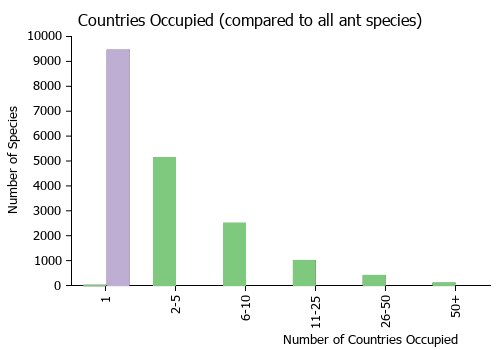Aenictus nganduensis
| Aenictus nganduensis | |
|---|---|

| |
| Scientific classification | |
| Kingdom: | Animalia |
| Phylum: | Arthropoda |
| Class: | Insecta |
| Order: | Hymenoptera |
| Family: | Formicidae |
| Subfamily: | Dorylinae |
| Genus: | Aenictus |
| Species: | A. nganduensis |
| Binomial name | |
| Aenictus nganduensis Wilson, 1964 | |
Nothing is known about the biology of Aenictus nganduensis.
Identification
A member of the ceylonicus group.
Key to Aenictus species groups
Distribution
Latitudinal Distribution Pattern
Latitudinal Range: -7.199999809° to -7.333333333°.
| North Temperate |
North Subtropical |
Tropical | South Subtropical |
South Temperate |
- Source: AntMaps
Distribution based on Regional Taxon Lists
Indo-Australian Region: New Guinea (type locality).
Distribution based on AntMaps
Distribution based on AntWeb specimens
Check data from AntWeb
Countries Occupied
| Number of countries occupied by this species based on AntWiki Regional Taxon Lists. In general, fewer countries occupied indicates a narrower range, while more countries indicates a more widespread species. |

|
Estimated Abundance
| Relative abundance based on number of AntMaps records per species (this species within the purple bar). Fewer records (to the left) indicates a less abundant/encountered species while more records (to the right) indicates more abundant/encountered species. |

|
Biology
Castes
Known only from the worker caste.
Images from AntWeb

| |
| Worker. Specimen code casent0281957. Photographer Shannon Hartman, uploaded by California Academy of Sciences. | Owned by NHMUK, London, UK. |
Nomenclature
The following information is derived from Barry Bolton's Online Catalogue of the Ants of the World.
- nganduensis. Aenictus nganduensis Wilson, 1964a: 470, figs. 47, 48 (w.) NEW GUINEA (Papua New Guinea).
- Type-material: holotype worker, 1 paratype worker.
- Type-locality: holotype Papua New Guinea, Huon Peninsula, Mongi-Mape Watershed, Nganduo, 1955, no. 738, midmountain rainforest (E.O. Wilson); paratype with same data.
- Type-depository: MCZC.
- Status as species: Bolton, 1995b: 60.
- Distribution: Papua New Guinea.
Unless otherwise noted the text for the remainder of this section is reported from the publication that includes the original description.
Description
Worker
Holotype: HW 0.58 mm, HL 0.61 mm, SL 0.53 mm. Antenna 10-segmented. Mandibles narrow, 3-toothed; in closure a gap remains between their posterior border and the anterior clypeal border nearly as wide as the maximum mandibular width. Clypeus shallowly concave, unarmed. Parafrontal ridge absent. Occiput convex, lacking collar. Propodeal junction acutely angulate. Subpetiolar process large, consisting of an acutely angular, forward-directed flange. Pilosity moderately abundant; length of longest pronotal hairs about 0.20mm.
Head shining. Pronotum and mesonotum shining. Remainder of mesosoma microreticulate (reticular diameters about 0.01 mm) and opaque. Mesopleuron in addition bearing 3 coarse longitudinal rugae. Dorsum of postpetiole shining; remainder of pedicel microreticulate and opaque.
Paratype: HW 0.56 mm, HL 0.61 mm, SL 0.51 mm. Nearly identical to holotype.
Type Material
Type locality: Nguanduo, 1000 m, Mongi-Mape Watershed, Huon Peninsula, NE New Guinea, midmountain rain forest (Wilson, acc. No. 738).
References
- Wilson, E. O. 1964a. The true army ants of the Indo-Australian area (Hymenoptera: Formicidae: Dorylinae). Pac. Insects 6: 427-483 (page 470, figs. 47, 48 worker described)
References based on Global Ant Biodiversity Informatics
- Borowiec M. L. 2016. Generic revision of the ant subfamily Dorylinae (Hymenoptera, Formicidae). ZooKeys 608: 1–280.
- CSIRO Collection
- Janda M., G. D. Alpert, M. L. Borowiec, E. P. Economo, P. Klimes, E. Sarnat, and S. O. Shattuck. 2011. Cheklist of ants described and recorded from New Guinea and associated islands. Available on http://www.newguineants.org/. Accessed on 24th Feb. 2011.
- Wilson E. O. 1964. The true army ants of the Indo-Australian area (Hymenoptera: Formicidae: Dorylinae). Pacific Insects 6: 427-483.


